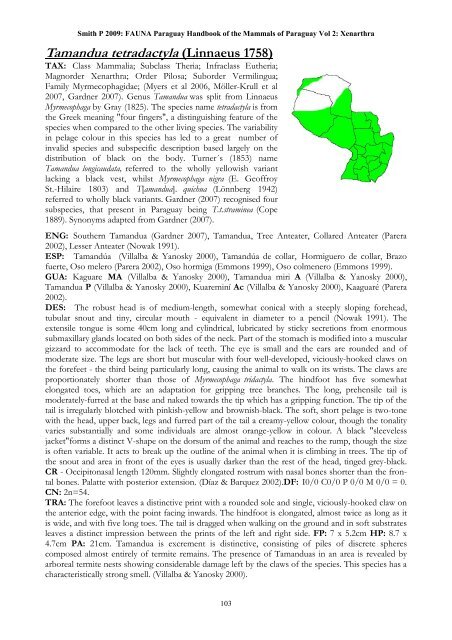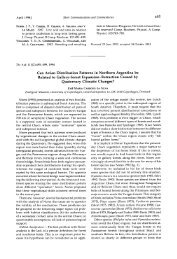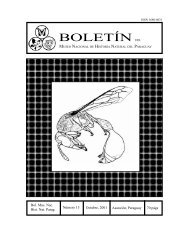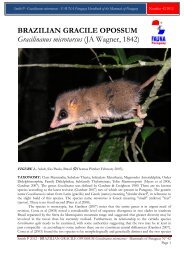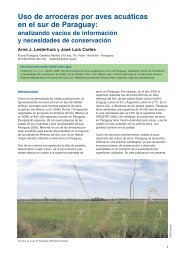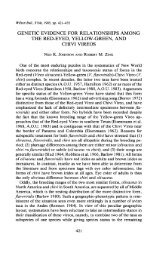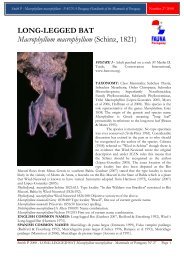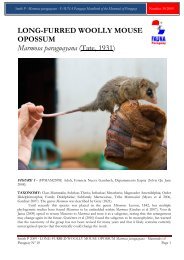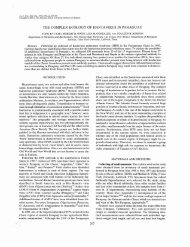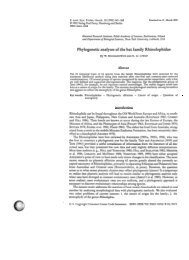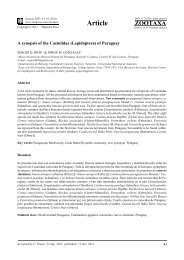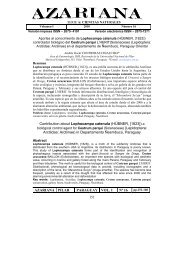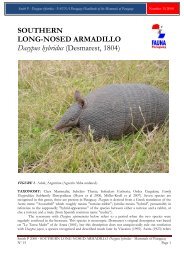hbk mammals vol 2 - FAUNA Paraguay
hbk mammals vol 2 - FAUNA Paraguay
hbk mammals vol 2 - FAUNA Paraguay
Create successful ePaper yourself
Turn your PDF publications into a flip-book with our unique Google optimized e-Paper software.
Smith P 2009: <strong>FAUNA</strong> <strong>Paraguay</strong> Handbook of the Mammals of <strong>Paraguay</strong> Vol 2: Xenarthra<br />
Tamandua tetradactyla (Linnaeus 1758)<br />
TAX: Class Mammalia; Subclass Theria; Infraclass Eutheria;<br />
Magnorder Xenarthra; Order Pilosa; Suborder Vermilingua;<br />
Family Myrmecophagidae; (Myers et al 2006, Möller-Krull et al<br />
2007, Gardner 2007). Genus Tamandua was split from Linnaeus<br />
Myrmecophaga by Gray (1825). The species name tetradactyla is from<br />
the Greek meaning "four fingers", a distinguishing feature of the<br />
species when compared to the other living species. The variability<br />
in pelage colour in this species has led to a great number of<br />
invalid species and subspecific description based largely on the<br />
distribution of black on the body. Turner´s (1853) name<br />
Tamandua longicaudata, referred to the wholly yellowish variant<br />
lacking a black vest, whilst Myrmecophaga nigra (E. Geoffroy<br />
St.-Hilaire 1803) and T[amandua]. quichua (Lönnberg 1942)<br />
referred to wholly black variants. Gardner (2007) recognised four<br />
subspecies, that present in <strong>Paraguay</strong> being T.t.straminea (Cope<br />
1889). Synonyms adapted from Gardner (2007).<br />
ENG: Southern Tamandua (Gardner 2007), Tamandua, Tree Anteater, Collared Anteater (Parera<br />
2002), Lesser Anteater (Nowak 1991).<br />
ESP: Tamandúa (Villalba & Yanosky 2000), Tamandúa de collar, Hormiguero de collar, Brazo<br />
fuerte, Oso melero (Parera 2002), Oso hormiga (Emmons 1999), Oso colmenero (Emmons 1999).<br />
GUA: Kaguare MA (Villalba & Yanosky 2000), Tamandua miri A (Villalba & Yanosky 2000),<br />
Tamandua P (Villalba & Yanosky 2000), Kuareminí Ac (Villalba & Yanosky 2000), Kaaguaré (Parera<br />
2002).<br />
DES: The robust head is of medium-length, somewhat conical with a steeply sloping forehead,<br />
tubular snout and tiny, circular mouth - equivalent in diameter to a pencil (Nowak 1991). The<br />
extensile tongue is some 40cm long and cylindrical, lubricated by sticky secretions from enormous<br />
submaxillary glands located on both sides of the neck. Part of the stomach is modified into a muscular<br />
gizzard to accommodate for the lack of teeth. The eye is small and the ears are rounded and of<br />
moderate size. The legs are short but muscular with four well-developed, viciously-hooked claws on<br />
the forefeet - the third being particularly long, causing the animal to walk on its wrists. The claws are<br />
proportionately shorter than those of Myrmecophaga tridactyla. The hindfoot has five somewhat<br />
elongated toes, which are an adaptation for gripping tree branches. The long, prehensile tail is<br />
moderately-furred at the base and naked towards the tip which has a gripping function. The tip of the<br />
tail is irregularly blotched with pinkish-yellow and brownish-black. The soft, short pelage is two-tone<br />
with the head, upper back, legs and furred part of the tail a creamy-yellow colour, though the tonality<br />
varies substantially and some individuals are almost orange-yellow in colour. A black "sleeveless<br />
jacket"forms a distinct V-shape on the dorsum of the animal and reaches to the rump, though the size<br />
is often variable. It acts to break up the outline of the animal when it is climbing in trees. The tip of<br />
the snout and area in front of the eyes is usually darker than the rest of the head, tinged grey-black.<br />
CR - Occipitonasal length 120mm. Slightly elongated rostrum with nasal bones shorter than the frontal<br />
bones. Palatte with posterior extension. (Díaz & Barquez 2002).DF: I0/0 C0/0 P 0/0 M 0/0 = 0.<br />
CN: 2n=54.<br />
TRA: The forefoot leaves a distinctive print with a rounded sole and single, viciously-hooked claw on<br />
the anterior edge, with the point facing inwards. The hindfoot is elongated, almost twice as long as it<br />
is wide, and with five long toes. The tail is dragged when walking on the ground and in soft substrates<br />
leaves a distinct impression between the prints of the left and right side. FP: 7 x 5.2cm HP: 8.7 x<br />
4.7cm PA: 21cm. Tamandua is excrement is distinctive, consisting of piles of discrete spheres<br />
composed almost entirely of termite remains. The presence of Tamanduas in an area is revealed by<br />
arboreal termite nests showing considerable damage left by the claws of the species. This species has a<br />
characteristically strong smell. (Villalba & Yanosky 2000).<br />
103


